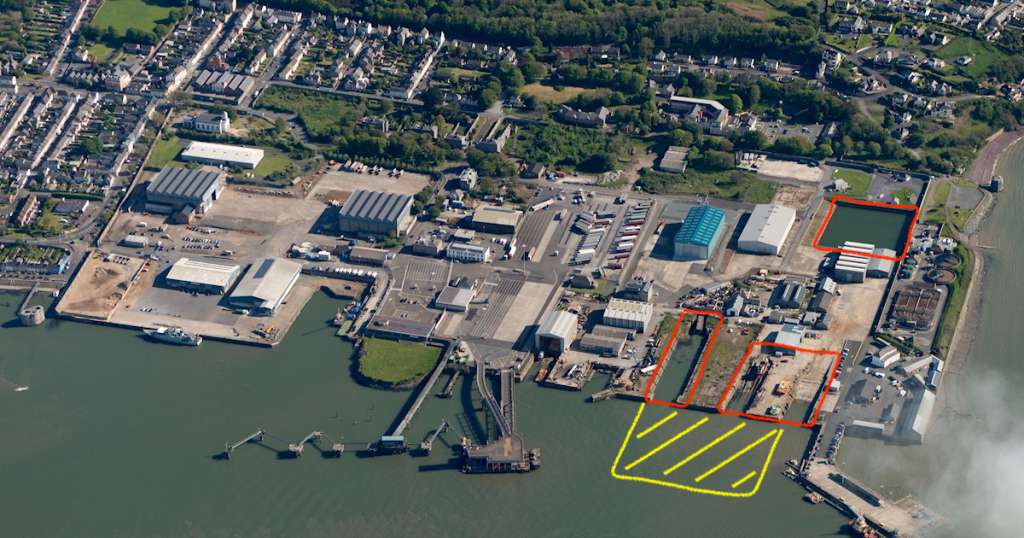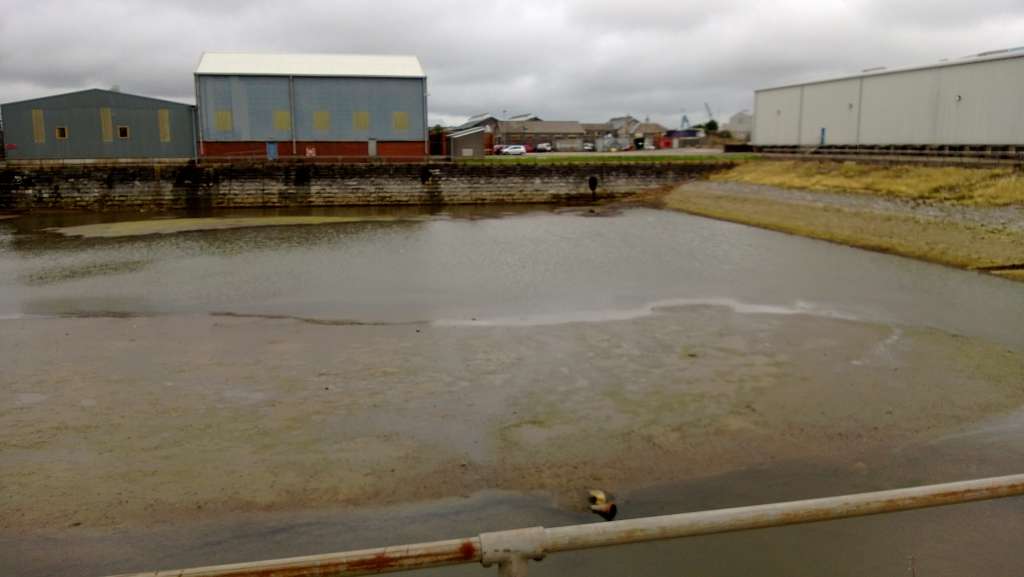PRESS RELEASE: Former historic Royal Naval Dockyard under threat
22nd January 2021
SAVE calls on Pembrokeshire County Council to safeguard Dock's precious Georgian and Victorian heritage
SAVE Britain’s Heritage has objected to plans submitted to Pembrokeshire County Council to infill four nationally listed maritime dock structures at the former Royal Dockyard of Pembroke Dock, south Wales. In our letter to the council, we have argued the proposed infilling would mean the total loss of a rare assemblage of late Georgian and early Victorian monuments.
The proposals, submitted by the Milford Haven Port Authority (MHPA), seek to infill two grade II listed slipways, a rare grade II listed timber pickling pond (used to season ships’ beams) and a grade II* listed graving dock. In their place, two 5-storey warehouses to house future ship building operations are proposed, as well as a giant concrete slipway, stretching out into the water alongside the grade II listed Hobbs point causeway.
The controversial plans have drawn objections from local and national heritage groups, including the Commodore Trust (which has long fought to protect and revive the historic dockyard), the Georgian Group and Naval Dockyards Society.
Benedict Oakley, conservation officer at SAVE Britain’s Heritage says: “If approved, these proposals would see a precious assemblage of listed naval monuments disappear from the heart of a conservation area and protected historic landscape. These plans risk making a mockery of the listing system designed to protect Wales’ historic environment.”
Adrian James, chair of the Commodore Trust, says: “These plans will see the destruction of a rare, if not unique, group of listed monuments that are a testament to the industry that gave birth to Pembroke Dock, revived the fortunes of Pembroke and gave the Milford Haven waterway a place in Wales, UK and world history.”
Ann Coats, chair of the Naval Dockyard Society, says: “The Royal Dockyard established at Pembroke Dock in 1814 was entirely unique: the only one in Wales, on the west coast of Britain, and the only one created solely as a shipbuilding facility. This application utterly negates the aims of the Pembroke Dockyard Conservation Area to conserve the listed dock, timber pond and slips which signify the origins of Pembroke Dock.”
Pembroke Dock is a designated conservation area and landscape of historic interest, characterised by numerous former naval monuments, including dry docks, ponds, slips and buildings, plus stunning views across Milford Haven to and from the dockyard and Pembroke Dock town.
Just outside the present application boundary stand numerous other heritage assets, some of the highest national significance. These include the grade I listed medieval Paterchurch Tower, two grade II* listed Cambridge Gun ‘Martello’ Towers, the grade II* listed former Commodore’s House and grade II listed Dockyard Chapel now converted into a heritage centre. Two grade II listed RAF Flying Boat hangers also survive on the dockyard, testament to the instrumental military role Pembroke Dock played right up to the 1960s. Looking down over this ensemble is Pembroke Dock’s Defensible Barracks, now grade II* listed and a Scheduled Ancient Monument.
View and comment on the plans here: https://www.pembrokeshire.gov.uk/planning-applications/commenting-on-applications, us, using application reference number 20/0732/PA.
Deadline for objections 29th January 2021.
History
Established in 1814, the Royal Dockyard at Pembroke Dock was built by the Navy Board to meet the demand for warships to defend Britain’s then burgeoning empire from the threat of Napolean. With the opening of the dockyard, the contemporaneous garrison town of Pembroke Dock grew rapidly, with naval defences soon established around the Pembroke peninsula, including two grade II listed Martello Towers and a defendable barracks, listed grade II* and a Scheduled Ancient Monument.
Situated at the southern side of the Milford Haven Waterway, Pembroke Dock was the most important naval outpost on the west coast of the British Isles for well over 100 years. Over its 112 years of active service, the Dockyard saw the construction of five Royal Yachts and 263 other Royal Naval vessels, with the last ship built and launched in April 1922.
Following the dock’s closure in 1926, the Royal Air Force established a flying boat base at Pembroke which operated for a further 29 years, launching several flying boats into service, including the Sunderland in 1938. During the Second World War, Pembroke Dock became the world’s largest flying boat station and a base to airmen from many countries.
Despite the end of military uses in the 1960s, the fine Victorian town with its grid-like street pattern and 125 listed buildings has expanded considerably in the past 50 years. The town retains a strong connection to its illustrious military and industrial past, whilst the former dockyard is now a commercial port and gateway by ferry to Ireland.
ENDS
Note to editors
1. For more information and images contact Ben Oakley, Conservation Officer at SAVE Britain's Heritage: ben.oakley@savebritainsheritage.org/ 07388 181 181.
2. A detailed account of Pembroke Dock’s history ‘Pembroke Dockyard and the Old Navy, A Bicentennial History’ has been published by author, navy history and former Lieutenant- Commander Lawrie Phillips.
3. SAVE Britain’s Heritage has been campaigning for historic buildings since its formation in 1975 by a group of architectural historians, writers, journalists and planners. It is a strong, independent voice in conservation, free to respond rapidly to emergencies and to speak out loud for the historic built environment.






